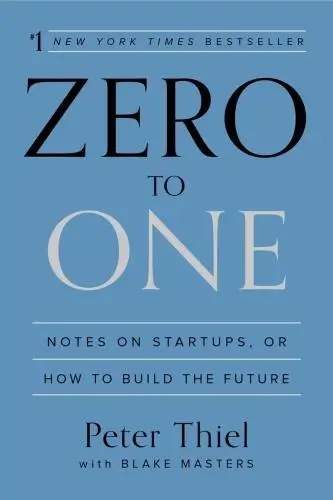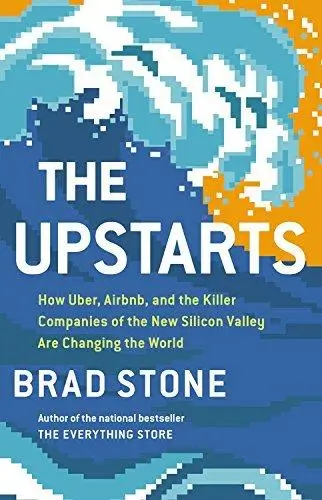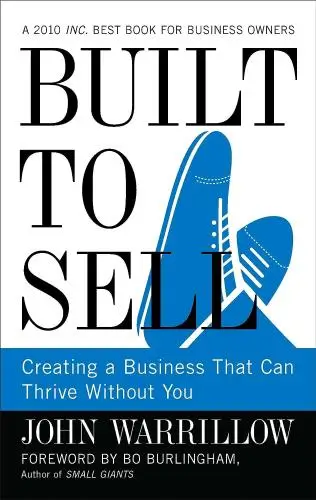
Zero to One
Notes on Startups, or How to Build the Future
What's it about?
Zero to One by Peter Thiel challenges readers to think outside the box and create something truly unique. Thiel argues that while going from 1 to n (replicating existing ideas) is easy, going from zero to one (creating something entirely new) is where true innovation lies. He emphasizes the importance of monopolies, innovation, and the power of technology in shaping the future. This book is a must-read for anyone looking to disrupt industries and make a lasting impact on the world.
About the Author
Peter Thiel is a Silicon Valley entrepreneur, investor, and author known for his contrarian views on technology and business. His book "Zero to One" explores the secrets of successful startups and challenges conventional wisdom. Thiel's writing style is straightforward and thought-provoking, offering unique perspectives on innovation, competition, and the future of technology. He is a co-founder of PayPal and Palantir Technologies, and is known for his bold and controversial statements on topics ranging from education to politics.
10 Key Ideas of Zero to One
Embrace and Pursue Monopoly, Not Competition
Strive for monopoly status within your market by offering a unique product or service that stands out from the competition.
This approach allows you to set your own prices, control market dynamics, and invest in innovation without the constant pressure of price wars.
A monopoly controls its destiny, whereas competitors in a crowded market fight over scraps, limiting growth and innovation.
Learn DeeperIdentify Your Unique Value Proposition: Start by understanding what makes your product or service unique. What can you offer that no one else can? This could be an innovative feature, a new approach to a common problem, or a unique customer experience.
Focus on Niche Markets: Instead of trying to appeal to everyone, target a specific niche where you can dominate. This allows you to tailor your offerings more closely to the needs of a specific group, making it easier to become the go-to provider in that space.
Innovate Continuously: Always look for ways to improve your product or service and stay ahead of potential competitors. This could involve technological advancements, exploring new markets, or enhancing customer service. Innovation is key to maintaining your monopoly status.
Build Strong Brand Loyalty: Create a strong connection with your customers through exceptional service, quality, and engagement. Customers loyal to your brand are less likely to switch to competitors, even if they appear, helping to secure your monopoly.
- Example
Google has effectively created a monopoly in the search engine market by continuously improving its search algorithms and user experience, making it the go-to search engine for the vast majority of internet users.
- Example
Tesla has carved out a significant niche in the electric vehicle market by offering innovative technology and superior performance, setting itself apart from traditional car manufacturers and dominating the electric vehicle space.
Focus on Proprietary Technology as a Competitive Advantage
Develop proprietary technology that is at least 10 times better than its closest substitute in some important dimension.
This significant improvement can create a strong barrier to entry for competitors and provides a solid foundation for building a monopoly.
It's not enough to be slightly better; your technology must offer a transformative solution to a pressing problem.
Learn DeeperIdentify a pressing problem: Start by pinpointing a significant issue that affects a considerable number of people or businesses. This problem should be one that current solutions do not adequately address.
Research and innovate: Dive deep into understanding the root causes of the problem. Invest time in research and development to create a solution that is not just incrementally better but significantly superior to existing alternatives.
Focus on scalability and adaptability: Ensure that your technology can easily scale and adapt to meet future demands and changes. This foresight can further solidify your competitive advantage.
Protect your innovation: Once you've developed your proprietary technology, take steps to protect it legally through patents or copyrights. This will help prevent others from easily copying your solution.
Test and refine: Before fully launching, test your technology with a small group of users. Gather feedback and make necessary adjustments. This iterative process can help perfect your offering.
Educate your market: Don't assume everyone will immediately understand the value of your innovation. Invest in marketing that educates your target audience about how your technology solves the problem in a way that's ten times better than existing solutions.
- Example
Google's search algorithm in the early days offered significantly more relevant search results compared to competitors, which was a key factor in its path to becoming a dominant player in the search engine market.
- Example
Tesla's electric vehicles (EVs) provided a range and performance that were far superior to what was available from other EVs at the time, helping to transform public perception of electric cars and establishing Tesla as a leader in the industry.
Prioritize Scalability from the Start
Design your business model to easily scale without being hampered by proportional increases in costs.
Scalability allows for exponential growth, enabling you to expand your reach and impact without a corresponding spike in expenses.
This means focusing on digital products or services that can be distributed globally at minimal marginal cost.
Learn DeeperIdentify Scalable Aspects of Your Business: Start by analyzing your current or planned business model. Look for products, services, or features that can be easily replicated or distributed without significant increases in cost. This could mean focusing on digital products, software, or platforms.
Leverage Automation and Technology: Implement automation tools and technology to handle repetitive tasks. This reduces the need for additional manpower as your customer base grows, keeping operational costs low while increasing efficiency.
Build a Strong Online Presence: Utilize social media, content marketing, and SEO strategies to reach a global audience at a fraction of the cost of traditional marketing methods. An effective online presence can help you scale your reach without proportionally increasing your marketing budget.
Optimize for Low-Cost Distribution: If your business involves physical products, focus on creating a streamlined, efficient distribution system. Consider drop shipping or partnering with established distributors to minimize your logistical expenses as you scale.
Invest in Scalable Infrastructure: Choose cloud-based services and scalable server solutions that can grow with your business. This ensures that your digital infrastructure can support increased demand without requiring costly upgrades or overhauls.
- Example
A software company develops a mobile app that helps users manage their daily tasks. Once the app is developed, it can be downloaded by millions of users worldwide, with minimal additional cost for each new user.
- Example
An online education platform creates a series of video courses on digital marketing. These courses can be accessed by an unlimited number of students globally, without the need for additional instructors, classrooms, or resources.
Cultivate a Strong Sales Strategy
Even the best product needs a strong sales strategy.
Understand the nuances of selling your product, including who your buyers are, how to reach them, and how to communicate your product's value effectively.
Sales is not just about transactions; it's about building relationships and trust with your customers.
Learn DeeperIdentify Your Target Market: Start by clearly defining who your product is for. Consider factors like age, location, interests, and needs. This will help you tailor your sales strategy to the people most likely to buy from you.
Craft a Compelling Value Proposition: Clearly articulate why your product is valuable and how it solves a problem or fulfills a need for your customers. This should be concise and compelling, making it easy for potential buyers to understand why they need your product.
Build Relationships with Your Customers: Sales is not just about making a one-time transaction. Focus on building long-term relationships by engaging with your customers, understanding their needs, and providing excellent service. This can lead to repeat business and referrals.
Leverage Multiple Sales Channels: Don't rely on just one method to reach your customers. Use a mix of channels such as online marketing, social media, email campaigns, and in-person events to broaden your reach and connect with your target market in different ways.
Measure and Adjust Your Strategy: Regularly review your sales performance and gather feedback from customers. Use this information to refine your sales approach, making adjustments to improve effectiveness and better meet the needs of your market.
- Example
A software company targeting small businesses might identify that their target market values cost-effectiveness and ease of use. They craft a value proposition highlighting how their software saves time and money, then reach out through LinkedIn and industry forums where small business owners gather, building relationships by offering valuable insights before pitching their product.
- Example
A local bakery looking to increase sales might realize their target market includes busy professionals looking for quick, healthy breakfast options. They decide to offer a subscription service for weekly pastry deliveries, promoting it through Instagram and local community groups, and asking current satisfied customers for referrals, thus building a loyal customer base through personalized service and convenience.
Build a Cohesive, Small Team
Start with a small, tightly-knit team of talented individuals who share your vision and are committed to the company's success.
A smaller team ensures more efficient communication and decision-making, fostering an environment where innovative ideas can flourish.
Each member should have a clear, unique role that contributes directly to the company's objectives.
Learn DeeperIdentify Core Team Members: Start by identifying a small group of individuals who not only have the skills necessary for your venture but also share your vision and passion. Look for complementary skills so that each member brings something unique to the table.
Foster Open Communication: Establish regular team meetings and encourage open dialogue about challenges, ideas, and progress. Use tools like Slack or Microsoft Teams to keep conversations flowing even outside of scheduled meetings.
Define Clear Roles and Goals: Make sure each team member knows their specific role and how it contributes to the overall objectives of the company. Set short-term and long-term goals together to ensure everyone is aligned and working towards the same vision.
Cultivate a Culture of Trust and Respect: Encourage feedback and constructive criticism within the team. Celebrate successes together and support each other through setbacks. A strong team is built on mutual respect and trust.
Encourage Innovation and Creativity: Create an environment where team members feel safe to propose new ideas and experiment. Sometimes, the most innovative solutions come from small teams empowered to think outside the box.
- Example
In the early days of Google, Larry Page and Sergey Brin formed a small team of talented individuals who were deeply invested in the company's mission to organize the world's information. Their clear, shared vision and complementary skills were crucial to Google's success.
- Example
When starting WhatsApp, Brian Acton and Jan Koum focused on building a small but highly skilled team. They prioritized open communication and a shared belief in simplicity and reliability, which helped them create a globally successful messaging app.
Deeper knowledge. Personal growth. Unlocked.
Unlock this book's key ideas and 15M+ more. Learn with quick, impactful summaries.
Read Full SummarySign up and read for free!
Zero to One Summary: Common Questions
Experience Personalized Book Summaries, Today!
Discover a new way to gain knowledge, and save time.
Sign up for our 7-day trial now.
No Credit Card Needed

Similar Books

$100M Offers
Alex Hormozi
Principles of Marketing, Global Edition
Gary Armstrong
The 100 Best Business Books of All Time
Jack Covert
Playing to Win
A.G. Lafley
Productize
Eisha Armstrong
Start Your Own Pet-Sitting Business and More
Entrepreneur Press
The 22 Immutable Laws of Marketing
Al Ries
The Upstarts
Brad Stone
Lean Analytics
Alistair Croll
Built to Sell
John WarrillowTrending Summaries

Peak
Anders Ericsson
Never Split the Difference
Chris Voss
Smart Brevity
Jim VandeHei
The Psychology of Money
Morgan Housel
The First 90 Days
Michael D. Watkins
Atomic Habits
James Clear
Thinking, Fast and Slow
Daniel Kahneman
The Body Keeps the Score
Bessel van der Kolk M.D.
The Power of Regret
Daniel H. Pink
The Compound Effect
Darren HardyNew Books

Job Interviews For Dummies®
Joyce Lain Kennedy
Job Interviews In A Week
Alison Straw
Handbook of Career Development
Gideon Arulmani
The Art of Spending Money
Morgan Housel
$100M Offers
Alex Hormozi
A Candle for Kiri
Edna Mae Holm
Principles of Marketing, Global Edition
Gary Armstrong
Serpent Rising: The Kundalini Compendium
Neven Paar
Feeling Is the Secret
Neville Goddard
